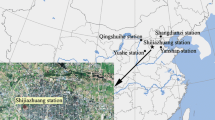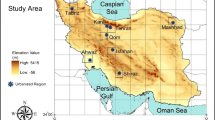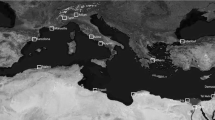Abstract
Although previous studies show that urbanization contributes to less than 10 % of the long-term regional total warming trend of mean surface air temperature in northeast China (Li et al. 2010), the urban heat island (UHI) impact on extreme temperatures could be more significant. This paper examines the urbanization impact on extreme winter minimum temperatures from 33 stations in North China during the period of 1957–2010. We use the Generalized Extreme Value (GEV) distribution to analyze the distribution of extreme minimum temperatures and the long-term variations of the three distributional characteristics parameters. Results suggest that among the three distribution parameters, the position parameter is the most representative in terms of the long-term extreme minimum temperature change. A new classification method based on the intercommunity (factors analysis method) of the temperature change is developed to detect the urbanization effect on winter extreme minimum temperatures in different cities. During the period of rapid urbanization (after 1980), the magnitude of variations of the three distribution parameters for the urban station group is larger than that for the reference station group, indicating a higher chance of occurrence of warmer weather and a larger fluctuation of temperatures. Among different types of cities, the three parameters of extreme minimum temperature distribution of the urban station group are, without exception, higher than those of the reference station group. The urbanization of different types of cities all show a warming effect, with small-size cities have the most evident effects on extreme minimum temperatures.






Similar content being viewed by others
References
Alexander LV et al (2006) Global observed changes in daily climate extremes of temperature and precipitation. J Geophys Res 111, D05109. doi:10.1029/2005JD006290
Brohan P, Kennedy JJ, Harris I et al (2006) Uncertainty estimates in regional and global observed temperature changes: a new data set from 1850. J Geophys Res 111, D12106. doi:10.1029/2005JD006548
Chen Y, Li X, Chen M et al (2008) Research on general exteme value distribution linear matrix which takes account of historical data on floods. J China Hydrol 28(3):8–13 (in Chinese)
Chen Z, Liu Z, Lu J (2010) Comparative analysis of parameter estimation methods of generalized extreme value distribution. Acta Sci Nat Univ Sun Yat-sen 48(6):105–109 (in Chinese)
Chu Z, Ren G (2005) The impact of change in Beijing metropolis heat island intensity on regional temperature series. Trans Meteorol 63(4):534–540 (in Chinese)
Coles SG (2001) An introduction to statistical modeling of extreme values. Springer
Du Y, Xie Z, Zeng Y et al (2007) Impact of urban expansion on regional temperature change in the Yangtze River Delta. J Geogr Sci 17(4):387–398. doi:10.1007/s11442-007-0387-0
Easterling DR et al (1997) Maximum and minimum temperature trends for the globe. Science 277(5324):364–367
Fang F, Bai H, Zhao H et al (2007) The urbanization effect in Northwestern China and its contribution to temperature warming. Plateau Meteorol 26(3):579–585 (in Chinese)
Hansen J, Ruedy R, Sato M, Lo K (2010) Global surface temperature change. Rev Geophys 48, RG4004. doi:10.1029/2010RG000345
Hua L, Ma Z, Guo W (2008) The impact of urbanization on air temperature across China. Theor Appl Climatol 93(3):179–194
Huang J (2007) Methods of meteorological statistical analysis and forecast. Meteorology Press, Beijing
IPCC (2007) Climate change: the physical science basis. Contribution of working group I to the fourth assessment report of the intergovernmental panel on climate change. Cambridge University Press, Cambridge
IPCC (2012) Managing the risks of extreme events and disasters to advance climate change adaptation, a special report of working groups I and II of the intergovernmental panel on climate change. Cambridge University Press, Cambridge and New York
Jones PD, Groisman PY, Coughlan M et al (1990) Assessment of urbanization effects in time series of surface air temperature over land. Nature 347:169–172
Jones PD, Lister DH, Li Q (2008) Urbanization effects in large-scale temperature records, with an emphasis on China. J Geophys Res 113, D16122. doi:10.1029/2008/JD009916
Kalnay E, Cai M (2003) Impact of urbanization and land-use change on climate. Nature 423(6939):528–531
Karl TR, Diaz HF, Kukla G (1988) Urbanization: its detection and effect in the United States climate record. J Clim 1:1099–1123
Kukla G, Gavin J (1986) Urban warming. J Clim Appl Meteorol 250:1265–1270
Li Q (2011) Introduction to research on climatic data homogenization [M]. Meteorological Press, Beijing
Li Q, Dong W (2009) Detection and adjustment of undocumented discontinuities in Chinese temperature series using a composite approach. Adv Atmos Sci 26(1):143–153. doi:10.1007/s00376-009-0143-8
Li Q, Huang J (2012) Long-term change in the extreme climate events of minimum temperature in Beijing. Plateau Meteorol 31(4):1145–1150 (in Chinese)
Li Q, Huang J (2013) Effects of urbanization in surrounding Bohai area on extreme summer warmest night temperatures, Acta Meteorologica Sinica 71(4):668–676 (in Chinese)
Li Q, Zhang H, Liu X et al (2004a) UHI effect on annual mean temperature during recent 50 years in china. Theor Appl Climatol 79:165–174
Li Q, Liu X, Zhang H et al (2004b) Detecting and adjusting on temporal inhomogeneity in Chinese mean surface air temperature dataset. Adv Atmos Sci 21(2):165–174
Li Q, Zhang H, Chen J et al (2009) A mainland China homogenized historical temperature dataset of 1951-2004. Bull Am Meteorol Soc 90:1062–1065. doi:10.1175/2009BAMS2736
Li Q, Li W, Si P et al (2010) Assessment of surface air warming in northeast China, with emphasis on the impacts of urbanization. Theor Appl Climatol. doi:10.1007/s00704-009-0155-4
Mohsin T, Gough WA (2012) Characterization and estimation of urban heat island at Toronto: impact of the choice of rural sites. Theor Appl Climatol 108(1–2):105–117
Parker DE (2004) Large-scale warming is not urban. Nature 432:290
Peterson TC (2003) Assessment of urban versus rural in situ surface temperature in the contiguous United States: no difference found. J Clim 16:2941–2959
Ren G, Zhou Y, Chu Z et al (2008) Urbanization effects on observed surface air temperature trends in North China. J Climate 21:1333–1348
Tang H, Zhai P, Wang Z (2005) On the change in the mean maximum and minimum temperature and diurnal range from 1951 to 1990. Clim Environ Res 10(4):728–735 (in Chinese)
Wang XL, Trewin B, Feng Y et al (2013a) Historical changes in Australian temperature extremes as inferred from extreme value distribution analysis. Geophys Res Lett 40:573–578. doi:10.1002/grl.50132
Wang X, Feng Y, Vincent L (2013b) Observed changes in one-in-20 year extremes of Canadian surface air temperatures. Atmos Ocean (accepted)
Yang X, Hou Y, Chen B (2011) Observed surface warming induced by urbanization in East China. J Geophys Res 116, D14113. doi:10.1029/2010/JD15452
Zhai P, Pan X (2003) The change in extreme events of temperature and precipitation in Northern China over the past 50 years. Geogr Trans 58(Supplement):1–10
Zhai P, Ren F (1997) On the change of China's maximum and minimum temperature in the recent 40 years. Acta Meteorologica Sinic 55(4):418–429 (in Chinese)
Zhang J, Dong W, Wu L et al (2005a) Impact of land use changes on surface warming in China. Adv Atmos Sci 22(3):343–348
Zhang XB, Gabriele H, Francis WZ, et al (2005b) Avoiding inhomogeneity in percentile-based indices of temperature extremes. J Clim 18:1641–1651
Zhou L, Dickinson RE, Tian Y et al (2004) Evidence for a significant urbanization effect on climate in China. Proc Natl Acad Sci U S A 101(26):9540–9544
Zhou L, Dai A, Dai Y et al (2009) Spatial dependence of diurnal temperature range trends on precipitation from 1950 to 2004. Clim Dyn 32:429–440. doi:10.1007/s00382-008-0387-5
Acknowledgments
The study is supported by: the State Key Development Program of Basic Research of China (2010CB951600; 2010CB428505), the National Science and Technology Supporting Plan of the Twelfth Five-Year (2012BAC22B05), National Natural Science Foundation of China (grant 40605021),China Meteorological Administration Special Foundation for Climate Change (CCSF201224). The first author has made an in-depth discussion with Dr. Wang Xiaolan on the separation of urbanization signal by GEV method during his visit to the Ministry of Environment in Canada. Dr. Yang Xuchao of Zhejiang Provincial Metrological Bureau provided data on nocturnal illumination and also technical support for the present study. And we would like to thank Prof. Phil Jones and Mr David Parker for their kindly reviewing an early version of this manuscript and their helpful comments to it.
Author information
Authors and Affiliations
Corresponding author
Electronic supplementary material
Below is the link to the electronic supplementary material.
ESM 1
(DOC 68 kb)
Rights and permissions
About this article
Cite this article
Li, Q., Huang, J., Jiang, Z. et al. Detection of urbanization signals in extreme winter minimum temperature changes over Northern China. Climatic Change 122, 595–608 (2014). https://doi.org/10.1007/s10584-013-1013-z
Received:
Accepted:
Published:
Issue Date:
DOI: https://doi.org/10.1007/s10584-013-1013-z




